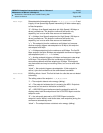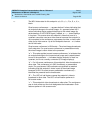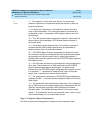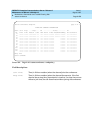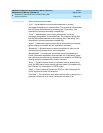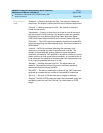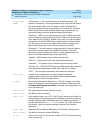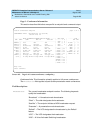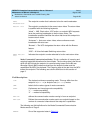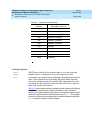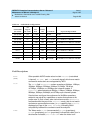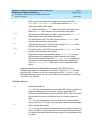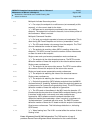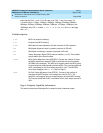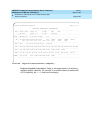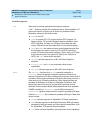
DEFINITY Enterprise Communications Server Release 6
Maintenance for R6vs/si
555-230-127
Issue 1
August 1997
Maintenance Commands and Trouble-Clearing Aids
Page 8-261status conference
8
Mode Commands/Communication Modes. This is a collection of incoming and
outgoing bandwidth allocations for the multiplex. The Incoming data is the rate at
which the MCU thinks the endpoint is communicating based on the Bit-rate
Allocation Signal (BAS) codes received from the endpoint/codec and the
capabilities the MCU has declared. The Outgoing data is the rate from the MCU
toward the endpoint. The following are column definitions for this section of
page 3.
Field descriptions
The following are field definitions for the Mode Commands/Communication
Modes section of Page 3.
Next
Broadcaster
The endpoint number that is selected to be the next broadcaster.
Return Vid The endpoint number that is the current return video. The return video
is qualified with the following keywords:
“blank” = VAS, Chair action, UCC action, or endpoint MCV requests
force the previous broadcaster to be the return video. The
broadcaster qualifier identifies the action that forced this endpoint to
become return video.
“Autoscan” = Auto scan return video, when conference mode
broadcasts with auto scan.
“Browse” = The UCC designates the return video with the Browse
feature.
“VAS” = A Voice Activated Switching return video.
Next Return
Vid
Indicates the endpoint number selected to be the next return video.
CONF
The desired conference operating mode. This may differ from the
endpoint in (EPT-IN) or endpoint out (EPT-OUT) modes.
CMD Labels for the various types of mode commands
STAT Conference and incoming mode compatibility.
“y” = mode compatibility
“n” = modes incompatibility.
EPT-IN defines the communication modes coming in from an endpoint.
EPT-OUT Defines the communication modes sent to an endpoint based on the
number of connected channels and the endpoint’s capabilities.
XRATE One of the supported rates in Table 8-4
:



